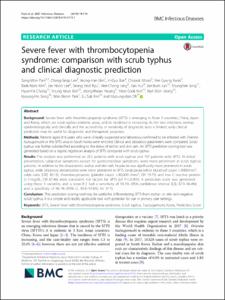KUMEL Repository
1. Journal Papers (연구논문)
1. School of Medicine (의과대학)
Dept. of Internal Medicine (내과학)
Severe fever with thrombocytopenia syndrome: comparison with scrub typhus and clinical diagnostic prediction
- Keimyung Author(s)
- Ryu, Seong Yeol
- Department
- Dept. of Internal Medicine (내과학)
- Journal Title
- BMC Infectious Diseases
- Issued Date
- 2019
- Volume
- 19
- Issue
- 1
- Keyword
- SFTS; Severe fever with thrombocytopenia syndrome; Scrub typhus; Tsutsugamushi; Korea; Prediction; Score
- Abstract
- Background:
Severe fever with thrombocytopenia syndrome (SFTS) is emerging in Asian 3 countries, China, Japan and Korea, which are scrub typhus endemic areas, and its incidence is increasing. As the two infections overlap epidemiologically and clinically and the accessibility or sensitivity of diagnostic tests is limited, early clinical prediction may be useful for diagnostic and therapeutic purposes.
Methods:
Patients aged ≥16 years who were clinically suspected and laboratory-confirmed to be infected with Orientia tsutsugamushi or the SFTS virus in South Korea were enrolled. Clinical and laboratory parameters were compared. Scrub typhus was further subclassified according to the status of eschar and skin rash. An SFTS prediction scoring tool was generated based on a logistic regression analysis of SFTS compared with scrub typhus.
Results:
The analysis was performed on 255 patients with scrub typhus and 107 patients with SFTS. At initial presentation, subjective symptoms except for gastrointestinal symptoms, were more prominent in scrub typhus patients. In addition to the characteristic eschar and skin rash, headache was significantly more prominent in scrub typhus, while laboratory abnormalities were more prominent in SFTS. Leukopenia (white blood cell count < 4000/mm3; odds ratio [OR] 30.13), thrombocytopenia (platelet count < 80,000 /mm3; OR 19.73) and low C-reactive protein (< 1 mg/dL; OR 67.46) were consistent risk factors for SFTS (all P < 0.001). A prediction score was generated using these 3 variables, and a score ≥ 2 had a sensitivity of 93.1% (95% confidence interval [CI], 87.9–96.4%) and a specificity of 96.1% (95% CI, 93.8–97.6%) for SFTS.
Conclusion:
This prediction scoring tool may be useful for differentiating SFTS from eschar- or skin rash-negative scrub typhus. It is a simple and readily applicable tool with potential for use in primary care settings.
- Keimyung Author(s)(Kor)
- 류성열
- Publisher
- School of Medicine (의과대학)
- Citation
- Sang-Won Park et al. (2019). Severe fever with thrombocytopenia syndrome: comparison with scrub typhus and clinical diagnostic prediction. BMC Infectious Diseases, 19(1), 174–174. doi: 10.1186/s12879-019-3773-1
- Type
- Article
- ISSN
- 1471-2334
- Source
- https://bmcinfectdis.biomedcentral.com/articles/10.1186/s12879-019-3773-1
- Appears in Collections:
- 1. School of Medicine (의과대학) > Dept. of Internal Medicine (내과학)
- 파일 목록
-
-
Download
 oak-2019-0061.pdf
기타 데이터 / 382.77 kB / Adobe PDF
oak-2019-0061.pdf
기타 데이터 / 382.77 kB / Adobe PDF
-
Items in Repository are protected by copyright, with all rights reserved, unless otherwise indicated.